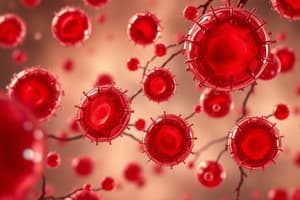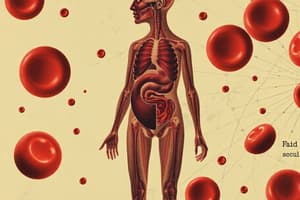Podcast
Questions and Answers
Which characteristic of red blood cells (RBCs) directly enhances their ability to efficiently transport oxygen?
Which characteristic of red blood cells (RBCs) directly enhances their ability to efficiently transport oxygen?
- The biconcave disc shape (correct)
- Their spherical shape
- The production of erythropoietin
- The presence of a nucleus
Plasma, primarily composed of proteins, constitutes approximately 75% of the total blood volume.
Plasma, primarily composed of proteins, constitutes approximately 75% of the total blood volume.
False (B)
What is the primary function of white blood cells (leukocytes) in the body?
What is the primary function of white blood cells (leukocytes) in the body?
immune defenses
The hormone __________ released by the kidneys, stimulates red blood cell production in the bone marrow.
The hormone __________ released by the kidneys, stimulates red blood cell production in the bone marrow.
Match each white blood cell type with its primary function:
Match each white blood cell type with its primary function:
If a patient's blood pH is measured to be 7.3, what condition might this indicate?
If a patient's blood pH is measured to be 7.3, what condition might this indicate?
Which of the following describes the process by which old or damaged red blood cells are removed from circulation?
Which of the following describes the process by which old or damaged red blood cells are removed from circulation?
Besides water, name three other components found in blood plasma.
Besides water, name three other components found in blood plasma.
Which of the following sequences correctly describes the steps involved in hemostasis?
Which of the following sequences correctly describes the steps involved in hemostasis?
Platelets are whole cells found in bone marrow that directly contribute to oxygen transport.
Platelets are whole cells found in bone marrow that directly contribute to oxygen transport.
What is the enzyme responsible for dissolving blood clots after the healing process is complete?
What is the enzyme responsible for dissolving blood clots after the healing process is complete?
The final step in the coagulation cascade involves the conversion of ______ to fibrin.
The final step in the coagulation cascade involves the conversion of ______ to fibrin.
Match each blood component with its primary function:
Match each blood component with its primary function:
Which of the following blood types can be safely transfused into a person with type AB blood?
Which of the following blood types can be safely transfused into a person with type AB blood?
The Rh factor is only important during blood transfusions and does not affect pregnancy.
The Rh factor is only important during blood transfusions and does not affect pregnancy.
Which of these is NOT a primary function of blood?
Which of these is NOT a primary function of blood?
Flashcards
What is Blood?
What is Blood?
A vital fluid that transports oxygen, nutrients, and waste products throughout the body.
Blood Components
Blood Components
Plasma, red blood cells, white blood cells, and platelets.
Plasma
Plasma
The liquid component of blood, mainly water, containing proteins, glucose, electrolytes, hormones, gases, and waste products.
Red Blood Cells (Erythrocytes)
Red Blood Cells (Erythrocytes)
Signup and view all the flashcards
White Blood Cells (Leukocytes)
White Blood Cells (Leukocytes)
Signup and view all the flashcards
Neutrophils
Neutrophils
Signup and view all the flashcards
Lymphocytes
Lymphocytes
Signup and view all the flashcards
Monocytes
Monocytes
Signup and view all the flashcards
Basophils
Basophils
Signup and view all the flashcards
Platelets (Thrombocytes)
Platelets (Thrombocytes)
Signup and view all the flashcards
Hemostasis
Hemostasis
Signup and view all the flashcards
Fibrin Formation
Fibrin Formation
Signup and view all the flashcards
Blood Functions
Blood Functions
Signup and view all the flashcards
Blood Groups
Blood Groups
Signup and view all the flashcards
ABO Blood Group System
ABO Blood Group System
Signup and view all the flashcards
Rh Blood Group System
Rh Blood Group System
Signup and view all the flashcards
Study Notes
- Blood is a vital bodily fluid in humans and animals
- Delivers essential substances like oxygen and nutrients to cells
- Transports metabolic waste away from cells
Blood Composition
- Consists of plasma and cells, including red blood cells, white blood cells, and platelets
- Volume is about 5 liters in an adult human
- Denser and more viscous than water
- Slightly alkaline, pH between 7.35 and 7.45
Plasma
- Makes up about 55% of blood volume
- Straw-colored liquid
- 92% water
- Contains dissolved substances:
- Proteins (albumin, globulins, fibrinogen)
- Glucose
- Electrolytes (Na+, Cl-, K+, etc.)
- Hormones
- Dissolved gases (O2, CO2)
- Waste products (urea, creatinine)
Red Blood Cells (Erythrocytes)
- Most abundant blood cells
- Responsible for transporting oxygen
- Biconcave discs, increasing surface area for gas exchange
- Mature RBCs lack a nucleus and organelles
- Primary component is hemoglobin, an iron-containing protein that binds to oxygen
- Produced in bone marrow through erythropoiesis
- Erythropoietin, released by kidneys, stimulates RBC production
- Lifespan of about 120 days
- Old or damaged RBCs are removed by the spleen and liver
White Blood Cells (Leukocytes)
- Involved in immune defenses
- Protect against infection and foreign invaders
- Less numerous than RBCs
- Five main types:
- Neutrophils
- Lymphocytes
- Monocytes
- Eosinophils
- Basophils
Neutrophils
- Most abundant WBC
- Phagocytic cells
- Ingest and destroy bacteria and fungi
- First responders to infection
Lymphocytes
- Include B cells (produce antibodies), T cells (coordinate immune response and kill infected cells), and natural killer (NK) cells (kill infected or cancerous cells)
- Important in adaptive immunity
Monocytes
- Differentiate into macrophages in tissues
- Phagocytic cells that ingest pathogens, dead cells, and debris
- Activate lymphocytes and other immune cells
Eosinophils
- Defend against parasitic infections
- Involved in allergic reactions
Basophils
- Release histamine and other mediators
- Promote inflammation
- Involved in allergic reactions
Platelets (Thrombocytes)
- Small, cell fragments
- Derived from megakaryocytes in bone marrow
- Crucial role in blood clotting (hemostasis)
- Aggregate at the site of blood vessel injury
- Form a temporary plug and activate the coagulation cascade
Hemostasis
- Process of stopping bleeding
- Involves:
- Vasoconstriction (reducing blood flow to the injured area)
- Platelet plug formation
- Blood coagulation (formation of a fibrin clot)
- Coagulation cascade involves clotting factors activating each other
- End result is conversion of fibrinogen to fibrin
- Fibrin forms a mesh to stabilize the platelet plug
- Clot retracts over time
- Dissolved by the enzyme plasmin
Blood Functions
- Transport:
- Oxygen from lungs to tissues
- Carbon dioxide from tissues to lungs
- Nutrients from the digestive system to tissues
- Hormones from endocrine glands to target organs
- Waste products from tissues to kidneys and liver
- Regulation:
- Body temperature (by distributing heat)
- pH (through buffers)
- Fluid and electrolyte balance
- Protection:
- White blood cells protect against infection
- Antibodies neutralize pathogens
- Blood clotting prevents blood loss
Blood Groups
- Classified based on antigens on red blood cell surfaces
- The ABO blood group system:
- A
- B
- AB
- O
- Rh blood group system:
- Rh-positive (Rh+)
- Rh-negative (Rh-)
- Blood transfusions must be compatible
- Incompatible transfusions can lead to agglutination (clumping) and hemolysis (destruction) of red blood cells
Studying That Suits You
Use AI to generate personalized quizzes and flashcards to suit your learning preferences.



